A Study on the Strategy for Departure Aircraft Pushback Control from the Perspective of Reducing Carbon Emissions
Abstract
:1. Introduction
2. Airport Surface Operation Data Analysis and Definition
2.1. Airport Surface Monitoring Data Analysis
2.2. Airport Surface Operation Data Definition
- Departure taxiing time: the total time of the aircraft’s pushback from the parking position to the time of taxiing to the departure runway, including the aircraft’s pushback, apron and taxiway taxiing, and the holding time the entrance of the runway (unit: minute).
- Number of airport surface aircraft: the total number of departing and arriving aircraft taxiing (including taxi wait) or undergoing pushback in the apron and taxiway systems (unit: flight).
- Number of departure aircraft: the number of departing aircraft that are taxiing (including the taxi wait) or undergoing pushback in the apron and taxiway systems (unit: flight).
- Runway utilization rate: the ratio of the length of time the runway is accumulatively occupied over a period of time to the length of the time period of the calculation.
- Takeoff and departure rate of flights: the number of departing aircraft per unit of time (unit: flights/minute).
- 6.
- Takeoff running: the duration from the point where a departing aircraft accelerates for takeoff on the runway until the aircraft’s landing gear tires are off the ground;
- 7.
- Departure waiting: the departing aircraft waits for takeoff clearance on the runway;
- 8.
- Final Approach: the duration from an arriving aircraft’s being at its final approach phase of 2.5 nm (nautical miles) from the runway’s end to the landing of the aircraft on the runway;
- 9.
- Landing: the duration of an arriving aircraft’s starting to land to when it is off the runway;
- 10.
- Cross-taxi: the aircraft crosses over the runway.
3. Runway Capacity Analysis
3.1. Runway Utilization Rate Analysis
3.2. Analysis of Flight Takeoff Rate
4. Aircraft Departure Time Prediction
4.1. Factors Affecting Departure Taxiing Time
4.2. Impact of the Number of Aircraft on the Airport Surface
4.3. Effect of Aircraft Departure Taxiing Distance
4.4. Departure Taxiing Time Prediction Model
5. Pushback Strategy for Departure on the Airport Surface
5.1. Implementation of Control Strategies
5.2. SIMMOD Simulation
5.3. Analysis of Fuel Saving and Emission Reduction Data
6. Conclusions
Author Contributions
Funding
Acknowledgments
Conflicts of Interest
References
- María, V.M.; Hall, C.A. Modelling Performance and Emissions from Aircraft for the Aviation Integrated Modelling project. J. Aircr. 2010, 47, 812–819. [Google Scholar]
- Jung, Y. Fuel Consumption and Emissions from Airport Taxi Operations. Available online: https://core.ac.uk/display/10559073 (accessed on 17 August 2018).
- Balakrishnan, H.; Jung, Y. A Framework for Coordinated Surface Operations Planning at Dallas-Fort Worth International Airport. Available online: https://arc.aiaa.org/doi/abs/10.2514/6.2007-6553 (accessed on 13 September 2108).
- Simaiakis, I.; Balakrishnan, H. Queuing Models of Airport Departure Processes for Emissions Reduction. Available online: https://arc.aiaa.org/doi/10.2514/6.2009-5650 (accessed on 13 September).
- Jung, Y.C.; Hoang, T.; Montoya, J. A Concept and Implementation of Optimized Operations of Airport Surface Traffic. Available online: https://arc.aiaa.org/doi/abs/10.2514/6.2010-9213 (accessed on 13 September).
- Lee, H.; Simaiakis, I.; Balakrishnan, H. A comparison of aircraft trajectory-based and aggregate queue-based control of airport taxi processes. In Proceedings of the 29th Digital Avionics Systems Conference, Salt Lake City, UT, USA, 3–7 October 2010; pp. 1–15. [Google Scholar]
- Simaiakis, I.; Khadilkar, H.; Balakrishnan, H.; Hansman, R.G. Demonstration of reduced airport congestion through pushback rate control. Transp. Res. Part A 2014, 66, 251–267. [Google Scholar] [CrossRef] [Green Version]
- Ravizza, S.; Atkin, J.A.D.; Maathuis, M.H.; Burke, E.K. A combined statistical approach and ground movement model for improving taxi time estimations at airports. J. Oper. Res. Soc. 2013, 64, 1347–1360. [Google Scholar] [CrossRef] [Green Version]
- Tang, Y. Aircraft Taxi Routes Planning and 3D Simulation for A-SMGCS. Ph.D. Thesis, Nanjing University of Aeronautics and Astronautics, Nanjing, China, December 2014. [Google Scholar]
- Zhao, X.; Tang, J.; Lu, F.; Han, B. Strategy Analysis for Delayed Fights Pushback and Sensitivity Analysis of the Length of Virtual Queue. J. Sichuan Univ. 2016, 3, 115–123. [Google Scholar]
- Li, N.; Lv, H. Method to Find out Path of Aircraft on Surface Based on Surface Movement Radar Data. Aeronaut. Comput. Tech. 2016, 46, 6–9. [Google Scholar]
- Lv, H. The Analysis of Aircraft Taxiing and Prediction Study Based on Surveillance Data. Master’s Thesis, Civil Aviation University of China, Beijing, China, April 2016. Available online: http://kns.cnki.net/KCMS/detail/detail.aspx?dbcode=CMFD&dbname=CMFD201701&filename=1016776031.nh&uid=WEEvREcwSlJHSldRa1FhdkJkVWI0UTA0a3RxcEdTZnNJVW1ZVVFkM3gvVT0=$9A4hF_YAuvQ5obgVAqNKPCYcEjKensW4IQMovwHtwkF4VYPoHbKxJw!!&v=MDAwNDFyQ1VSTEtmYnVkb0Z5bmhWYjdMVkYyNkdMUy9HTkhQcnBFYlBJUjhlWDFMdXhZUzdEaDFUM3FUcldNMUY= (accessed on 17 August 2018).
- Eurocontrol Standard Document for Surveillance Data Exchange Part 9: Category 062 SDPS Track Messages. Available online: https://www.google.com.tw/url?sa=t&rct=j&q=&esrc=s&source=web&cd=1&ved=2ahUKEwiHtb3gtLndAhWLyrwKHdT3AxoQFjAAegQIARAC&url=https%3A%2F%2Fwww.eurocontrol.int%2Fsites%2Fdefault%2Ffiles%2Fcontent%2Fdocuments%2Fnm%2Fasterix%2Farchives%2Fasterix-cat062-system-track-data-part9-v1.11-042010.pdf&usg=AOvVaw389n3cb5i1jElDR9PsFJ3s (accessed on 14 September 2018).
- Anderson, R.C.; Reeb, D.M. Founding-family Ownership and Firm Performance: Evidence from the S&P 500. J. Financ. 2003, 58, 1301–1328. [Google Scholar]
- Tsai, S.-B. Using the DEMATEL Model to Explore the Job Satisfaction of Research and Development Professionals in China’s Photovoltaic Cell Industry. Renew. Sustain. Energy Rev. 2018, 81, 62–68. [Google Scholar] [CrossRef]
- Lee, Y.-C.; Hsiao, Y.-C.; Peng, C.-F.; Tsai, S.-B.; Wu, C.-H.; Chen, Q. Using Mahalanobis-Taguchi System, Logistic Regression and Neural Network Method to Evaluate Purchasing Audit Quality. Available online: http://journals.sagepub.com/doi/10.1177/0954405414539934 (accessed on 13 September 2108).
- Liu, B.; Li, T.; Tsai, S.B. Low carbon strategy analysis of competing supply chains with different power structures. Sustainability 2017, 9, 835. [Google Scholar]
- Qu, Q.; Tsai, S.-B.; Tang, M.; Xu, C.; Dong, W. Marine ecological environment management based on ecological compensation mechanisms. Sustainability 2016, 8, 1267. [Google Scholar] [CrossRef]
- Lee, Y.-C.; Wang, Y.-C.; Chien, C.-H.; Wu, C.-H.; Lu, S.-C.; Tsai, S.-B.; Dong, W. Applying revised gap analysis model in measuring hotel service quality. SpringerPlus 2016, 5, 1191. [Google Scholar] [CrossRef] [PubMed]
- Wang, J.; Yang, J.; Chen, Q.; Tsai, S.-B. Collaborative Production Structure of Knowledge Sharing Behavior in Internet Communities. Mob. Inf. Syst. 2016, 2016, 8269474. [Google Scholar] [CrossRef]
- Tsai, S.-B.; Lee, Y.-C.; Guo, J.J. Using modified grey forecasting models to forecast the growth trends of green materials. Proc. Inst. Mech. Eng. Part B J. Eng. Manuf. 2014, 228, 931–940. [Google Scholar] [CrossRef]
- Ge, B.; Jiang, D.; Gao, Y.; Tsai, S.-B. The influence of legitimacy on a proactive green orientation and green performance: A study based on transitional economy scenarios in china. Sustainability 2016, 8, 1344. [Google Scholar] [CrossRef]
- Lee, S.-C.; Su, J.-M.; Tsai, S.-B.; Lu, T.-L.; Dong, W. A comprehensive survey of government auditors’ self-efficacy and professional Development for improving audit quality. SpringerPlus 2016, 5, 1263. [Google Scholar] [CrossRef] [PubMed]
- ICAO Aircraft Engine Emissions Databank. Available online: https://www.easa.europa.eu/easa-and-you/environment/icao-aircraft-engine-emissions-databank (accessed on 17 August 2018).
- Li, N.; Zhang, H.F. Calculating aircraft pollutant emissions during taxiing at the airport. Acta Sci. Circumstantiae 2017, 37, 1872–1876. [Google Scholar]

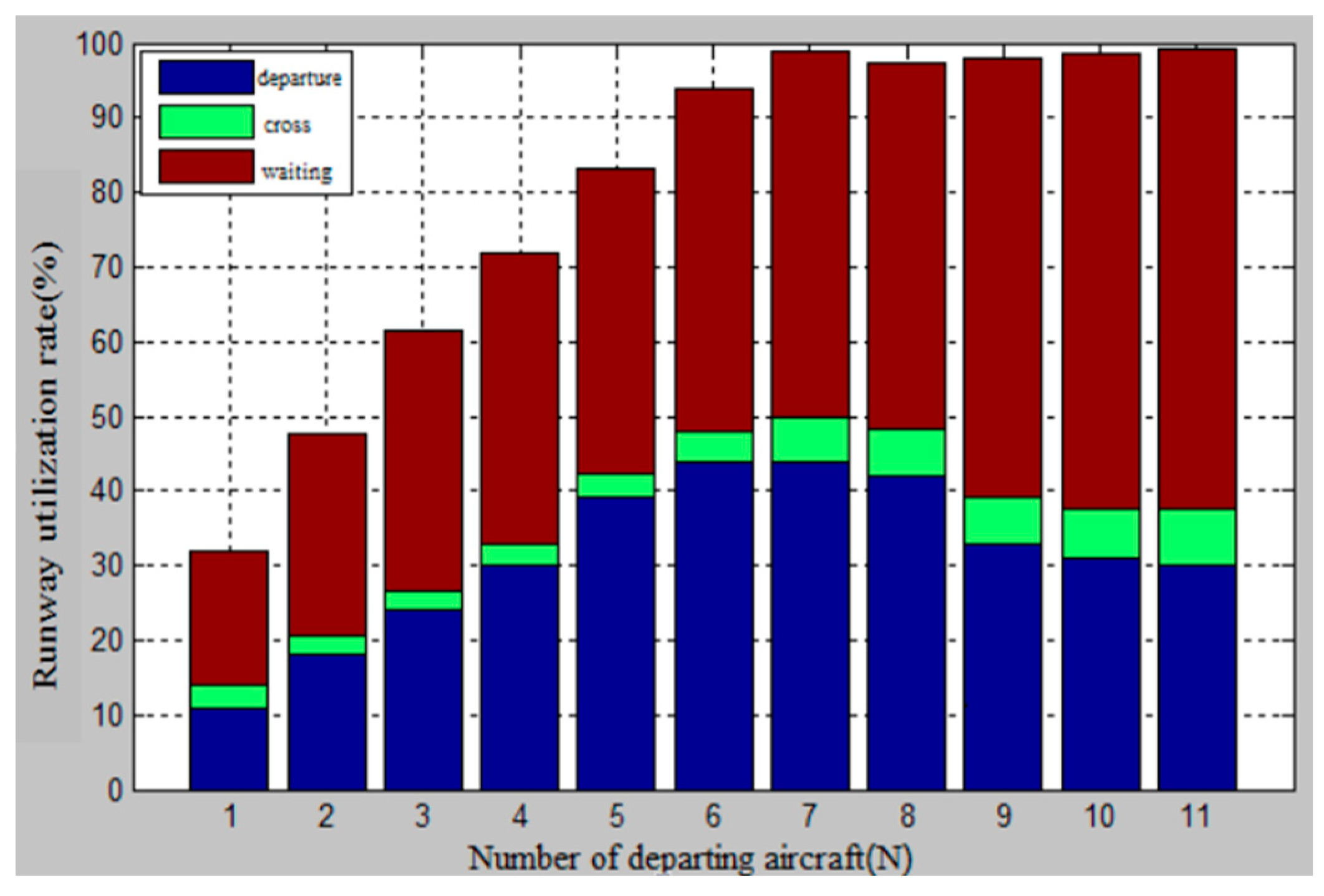

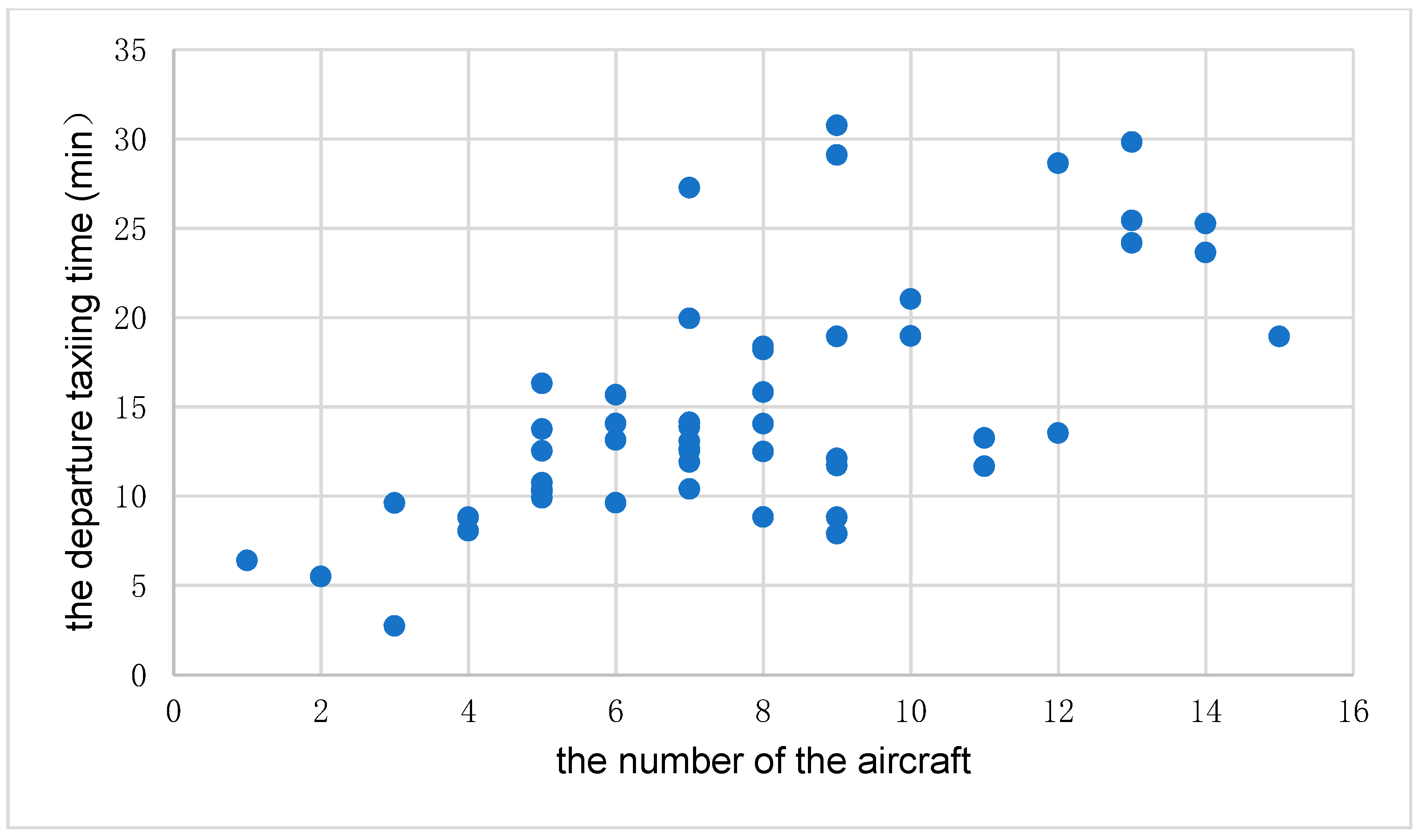
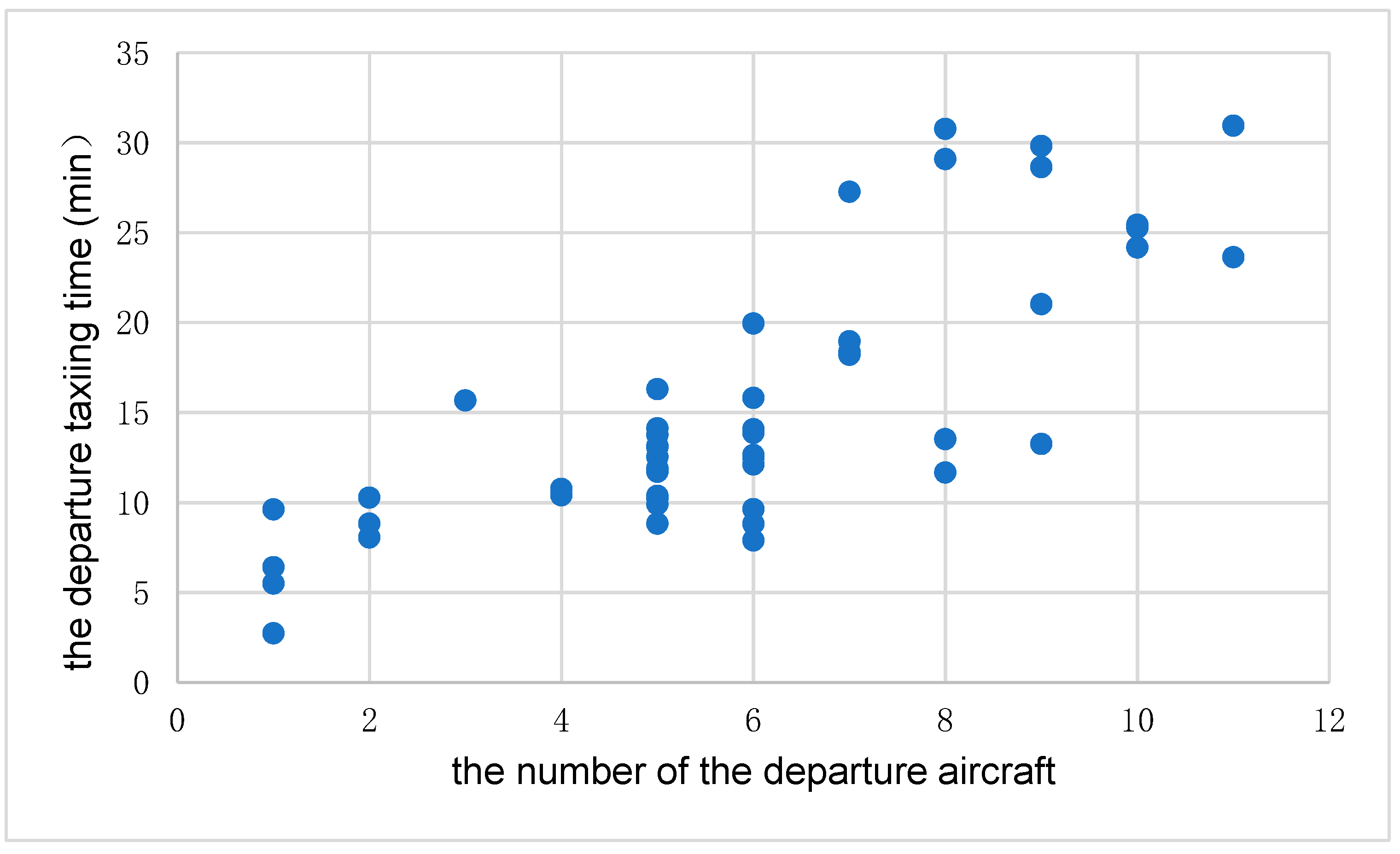
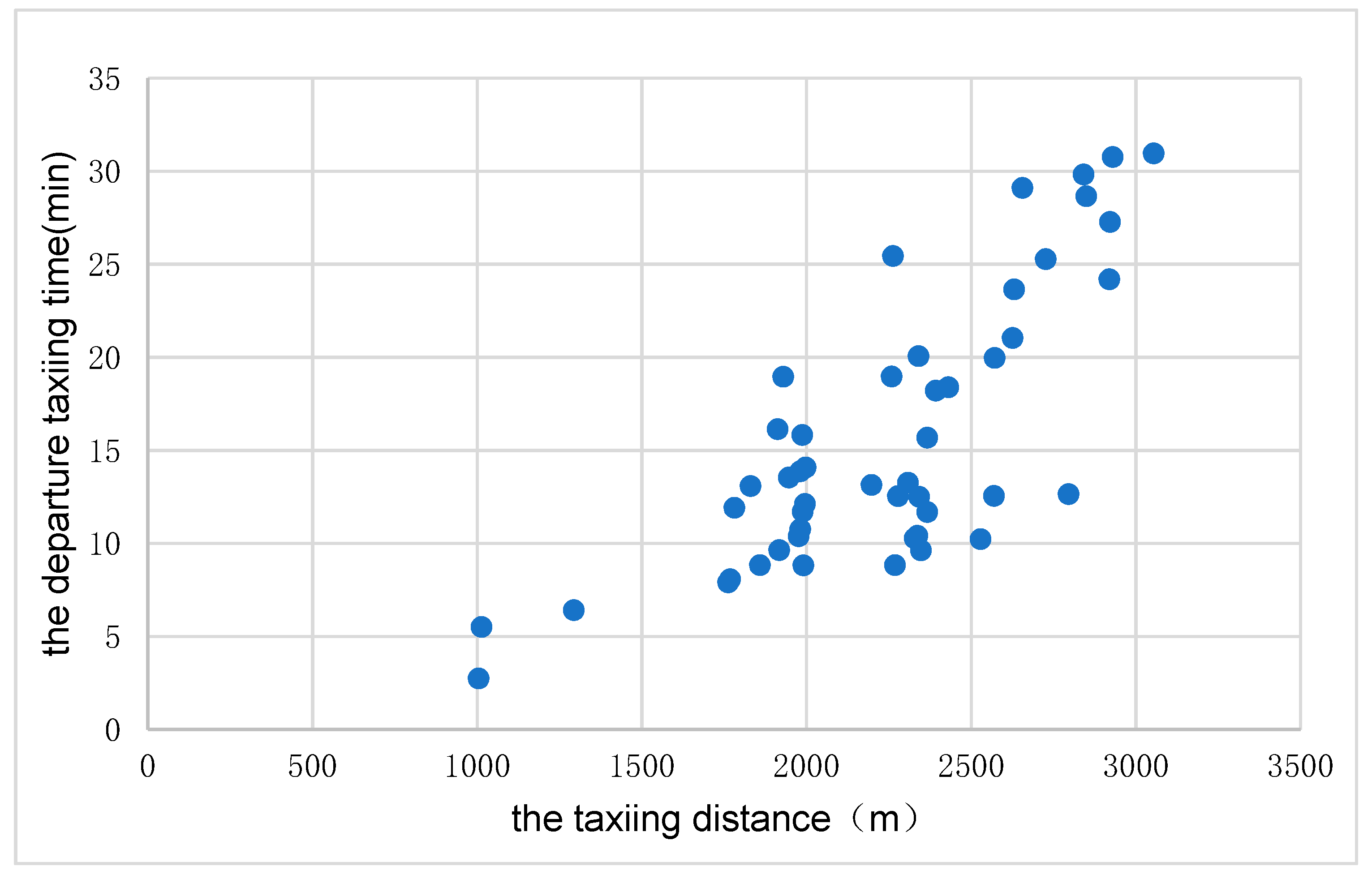
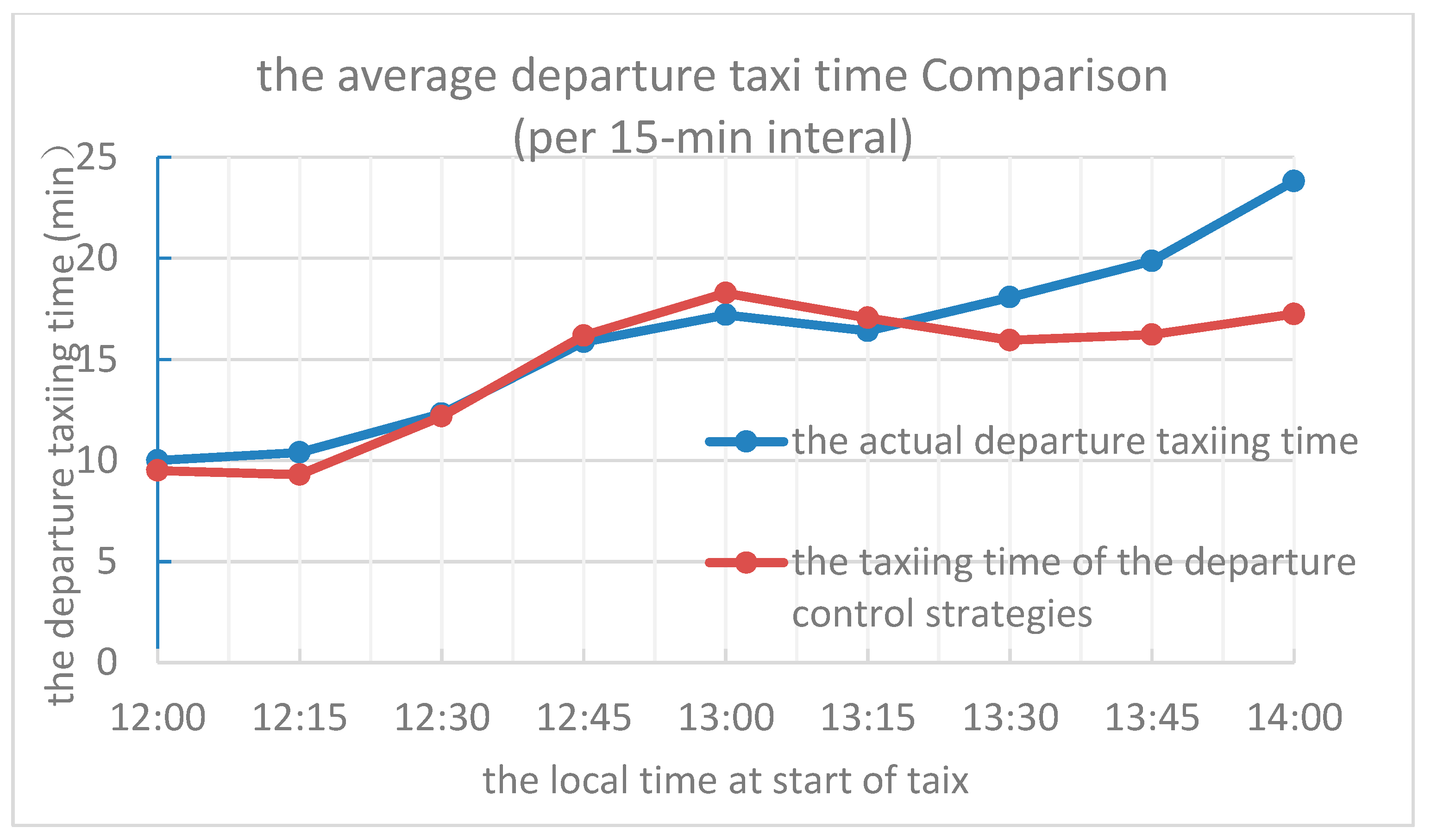
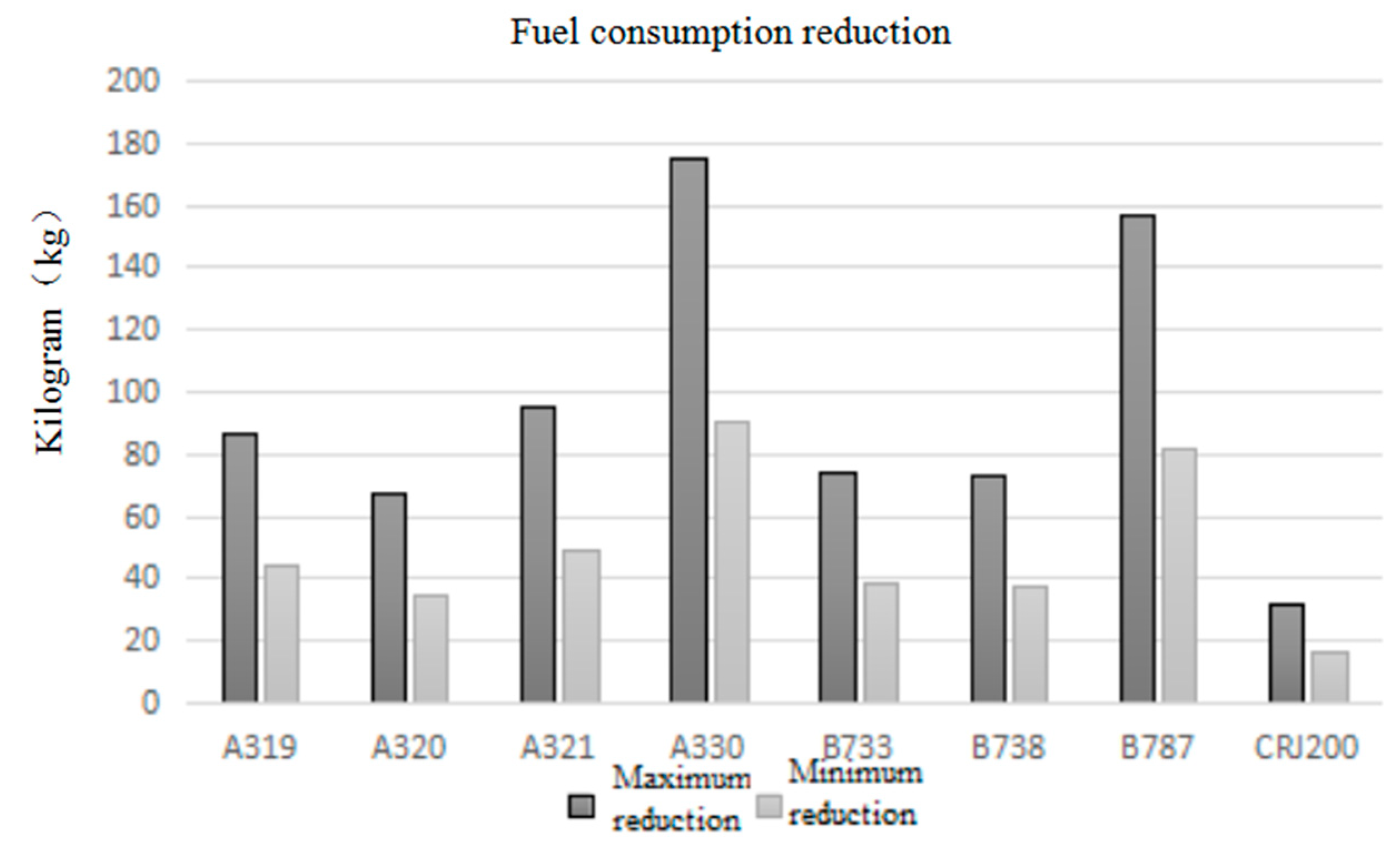

| Mean | Median | Standard Deviation | Max. | Min. | |
|---|---|---|---|---|---|
| the Departure Taxiing Time (Minutes) | 16.32 | 14.19 | 7.05 | 30.94 | 2.73 |
| the Number of the Departure Aircraft (Flights) | 5.90 | 6 | 2.55 | 11 | 1 |
| the Taxiing Distance (Meters) | 2232.37 | 2278 | 458.06 | 3055 | 1005 |
| the Number of Departure Aircraft | the Taxiing Distance | |
|---|---|---|
| the Number of Departure Aircraft | 1 | 0.66551 |
| the Taxiing Distance | 0.66551 | 1 |
| Variable | Coefficient | t-Statistic | Sig |
|---|---|---|---|
| C | −8.078409 | −2.81201 | ** |
| N | 1.353452 | 4.748534 | *** |
| d | 6.958 | 4.259463 | *** |
| Airport Surface Departure Aircraft Number (N) | Taxi Time (min) | Takeoff and Departure Rate (flight/min) | Runway Utilization (%) |
|---|---|---|---|
| 1 | 8.87 | 0.11 | 32.0 |
| 2 | 10.2 | 0.21 | 47.5 |
| 3 | 11.6 | 0.29 | 61.5 |
| 4 | 12.9 | 0.37 | 72.1 |
| 5 | 14.3 | 0.43 | 83.3 |
| 6 | 15.6 | 0.49 | 94.0 |
| 7 | 16.9 | 0.53 | 98.9 |
| 8 | 18.3 | 0.53 | 97.3 |
| 9 | 19.7 | 0.50 | 97.0 |
| 10 | 21.0 | 0.44 | 98.5 |
| 11 | 22.3 | 0.42 | 100 |
| Airport Surface Departure Aircraft Number (N) | Fuel Consumption (kg) | Pollutants Total Emissions (kg) |
|---|---|---|
| 6 | 194.6 | 6.28 |
| 7 | 210.9 | 6.81 |
| 8 | 228.4 | 7.37 |
| 9 | 245.9 | 7.94 |
| 10 | 262.1 | 8.46 |
| 11 | 278.3 | 8.98 |
© 2018 by the authors. Licensee MDPI, Basel, Switzerland. This article is an open access article distributed under the terms and conditions of the Creative Commons Attribution (CC BY) license (http://creativecommons.org/licenses/by/4.0/).
Share and Cite
Zhu, X.; Li, N.; Sun, Y.; Zhang, H.; Wang, K.; Tsai, S.-B. A Study on the Strategy for Departure Aircraft Pushback Control from the Perspective of Reducing Carbon Emissions. Energies 2018, 11, 2473. https://doi.org/10.3390/en11092473
Zhu X, Li N, Sun Y, Zhang H, Wang K, Tsai S-B. A Study on the Strategy for Departure Aircraft Pushback Control from the Perspective of Reducing Carbon Emissions. Energies. 2018; 11(9):2473. https://doi.org/10.3390/en11092473
Chicago/Turabian StyleZhu, Xinhua, Nan Li, Yu Sun, Hongfei Zhang, Kai Wang, and Sang-Bing Tsai. 2018. "A Study on the Strategy for Departure Aircraft Pushback Control from the Perspective of Reducing Carbon Emissions" Energies 11, no. 9: 2473. https://doi.org/10.3390/en11092473





